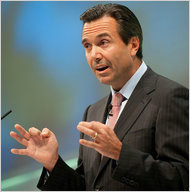 Leon Neal/Agence France-Presse — Getty ImagesAntónio Horta-Osório, chief executive of the Lloyds Banking Group.
Leon Neal/Agence France-Presse — Getty ImagesAntónio Horta-Osório, chief executive of the Lloyds Banking Group.
LONDON – The Lloyds Banking Group said on Tuesday that first-quarter net profit rose to £1.5 billion ($2.3 billion) from the period a year earlier, as it continued to reduce costs and shed assets.
The result, which beat analysts’ estimates, was a sharp turnaround from the £5 million loss Lloyds posted in the first quarter of 2012.
The bank’s performance was driven by higher revenue in its main retail banking business, falling costs as it sold assets and a reduction in money set aside to cover delinquent mortgages, Lloyds said in a statement.
“We made substantial progress again in the first quarter,” the chief executive, António Horta-Osório, said in the statement.
Shares in Lloyds, which is 39 percent owned by the British government after it received a bailout during the financial crisis, rose almost 5 percent in morning trading in London on Tuesday.
In recent years, Lloyds and other local lenders have had to pay billions of pounds for inappropriately selling insurance products to British customers who did not require them. The bank said it had not set aside additional money to cover the costs for that inappropriate activity.
As British regulators push banks to shore up their capital positions, Lloyds has been increasing its reserves through a series of disposals.
On Monday, Lloyds sold its Spanish operations to Banco Sabadell of Spain. Lloyds is also planning an initial public offering of part of its branch network to meet conditions of its government bailout in 2008. The bank made £394 million last month from selling a 20 percent stake in the wealth management firm St. James’s Place.
In March, regulators said British financial institutions would have to raise an additional £25 billion of capital. Many analysts expect that Lloyds will have to raise additional funds, though it said on Tuesday that it was still waiting to receive guidance from the local authorities.
The bank’s core Tier 1 ratio, a measure of a firm’s ability to weather financial shocks, remained at 8.1 percent under the accountancy rules known as Basel III.
During the first quarter, Lloyds said it had continued to reduce costs and cut the amount of money set aside to cover delinquent loans. Impairment charges fell 40 percent, to £1 billion, from the period a year earlier, while noncore assets fell 6 percent, to £92.1 billion.
Lloyds also said on Tuesday that Matthew Elderfield, deputy governor at the Central Bank of Ireland in charge of financial regulation, would become its new group director of conduct and compliance beginning in October.
Article source: http://dealbook.nytimes.com/2013/04/30/lloyds-profit-surges-to-2-3-billion/?partner=rss&emc=rss